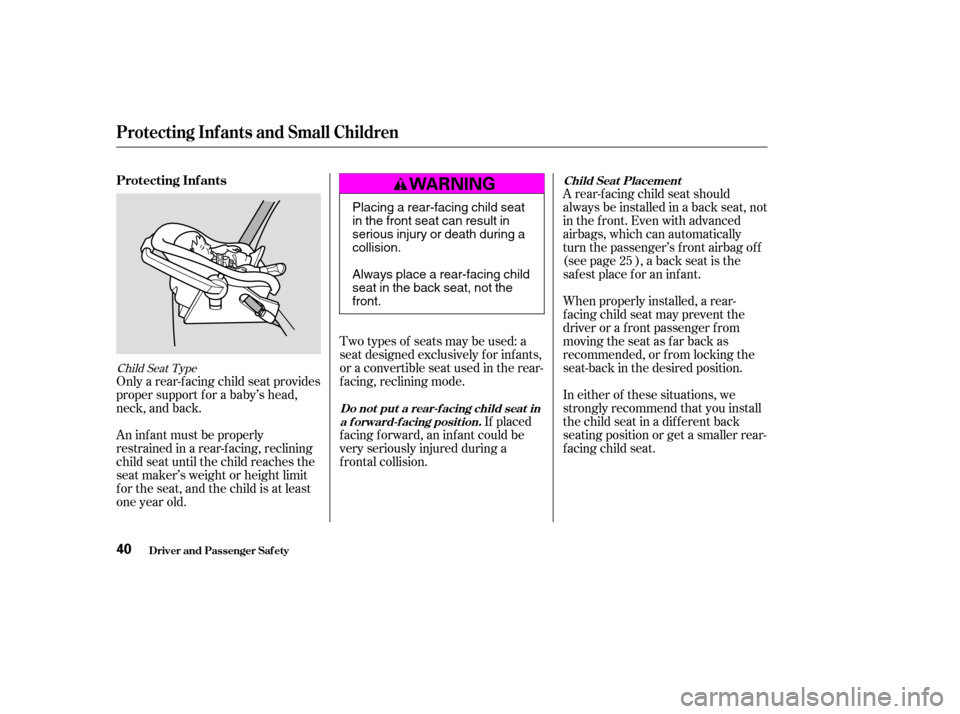Page 31 of 301

Your airbag systems are virtually
maintenance-f ree, and there are no
parts you can saf ely service.
However, you must have your
vehicle serviced if:Any airbag
that has deployed must be
replaced along with the control
unit and other related parts. If a
f ront airbag inf lates, the seat belt
tensioners must also be replaced.
Do not try to remove or replace
anyairbagbyyourself.Thismust
be done by a Honda dealer or a
knowledgeable body shop.
Take your vehicle to
an authorized Honda dealer as
soon as possible. If you ignore this
indication, your airbags may not
operate properly. Even if your
airbags do not inflate, your dealer
should inspect the driver’s seat
position sensor and the f ront
passenger’s weight sensors to
make sure they are operating
properly.
Additional Inf ormation About Your Airbags
Driver and Passenger Saf ety
Airbag ServiceAn airbag ever inf lates.
T he SRS indicat or light alert s yout o a problem. If your vehicle has a moderat e t o
severe impact .
32
�����—�����—�����y�
�
�����������y���
�(�������
���y���������y
Page 32 of 301

Together, airbags and
seat belts provide the best
protection.
Tampering could cause
the airbags to deploy, possibly
causing very serious injury.
If water or another liquid
soaks into a seat-back, it can
prevent the side airbag cutof f
system f rom working properly. This could make the
driver’s seat position sensor or the
f ront passenger’s weight sensors
inef f ective. If it is necessary to
remove or modif y a f ront seat to
accommodate a person with
disabilities, f irst contact American
Honda at 800-999-1009.
This could make the
driver’s seat position sensor and
the f ront passenger’s weight
sensors inef f ective. This could make the front
passenger’s weight sensors
inef f ective. Make sure the right
rear f loor mat is hooked over the
f loor mat anchor (see page ).
Improperly
replacing or covering f ront seat-
back covers can prevent your side
airbags f rom inf lating during a
side impact.
Pushing or
pulling on the back of the seat,
placing heavy items in the back
seat pocket, pushing cargo against
the seat, or hanging heavy items
on the seat back can interf ere with
the proper operation of the
passenger’s advanced front airbag. 235
Additional Inf ormation About Your Airbags
Driver and Passenger Saf ety
Additional Saf ety Precautions
Donotattempttodeactivateyour
airbags.
Do not t amper wit h airbagcomponent s or wiring f or any
reason.
Do not expose t he f ront seat -backsto liquid. Do not remove or modif y a f ront
seat wit hout consult ing a Hondadealer.
Do not place any it ems under t he front seats. Do not place t he right rear f loor
mat under t he f ront passenger’sseat .
Do not cover or replace f ront seat -back covers wit hout consult ing aHonda dealer.
Do not do anyt hing t hat wouldincrease or decrease weight on t hef ront passenger’s seat .
33
�����—�����—�����y�
�
�����������y���
�(�������
���y���������y
Page 37 of 301

�µ
Many parents say they pref er to put
an inf ant or small child in the f ront
passenger seat so they can watch the
child, or because the child requires
attention.
Placing a child in the f ront seat
exposes the child to hazards in a
f rontal collision, and paying close
attention to a child distracts the
driver from the important tasks of
driving, placing both of you at risk.
If a child requires physical attention
or f requent visual contact, we
strongly recommend that another
adult ride with the child in the back
seat. The back seat is far safer for a
child than the front.
Your vehicle has a back seat where
children can be properly restrained.
If you ever have to carry a group of
children, and a child must ride in
front:
Place the largest child in the f ront
seat, provided the child is large
enough to wear the lap/shoulder
belt properly (see page ).
Have the child sit upright and well
backintheseat(seepage ).
Make sure the seat belt is properly
positioned and secured (see page ). Neverholdaninfantorchildon
your lap. If you are not wearing a
seat belt in crash, you could be
thrown f orward and crush the
child against the dashboard or a
seat-back. If you are wearing a
seat belt the child can be torn
from your arms and be seriously
hurt or killed.
Move the vehicle seat as far to the
rear as possible. Never put a seat belt over yourself
and a child. During a crash, the
belt could press deep into the child
and cause serious or fatal injuries.
16
14 51If a Child Requires Close
Attention
If You Must Drive with Several
Children Additional Saf ety Precautions
Driver and Passenger Saf ety
Protecting Children General Guidelines
38
�����—�����—�����y�
�
�����������y���
�(�������
���y�������
�y
Page 39 of 301

Two types of seats may be used: a
seat designed exclusively f or inf ants,
or a convertible seat used in the rear-
f acing, reclining mode.If placed
f acing f orward, an inf ant could be
very seriously injured during a
f rontal collision.
An inf ant must be properly
restrained in a rear-f acing, reclining
child seat until the child reaches the
seat maker’s weight or height limit
f or the seat, and the child is at least
one year old.
Only a rear-f acing child seat provides
proper support f or a baby’s head,
neck, and back. A rear-f acing child seat should
always be installed in a back seat, not
in the front. Even with advanced
airbags, which can automatically
turn the passenger’s f ront airbag of f
(see page ), a back seat is the
saf est place f or an inf ant.
When properly installed, a rear-
f acing child seat may prevent the
driver or a f ront passenger f rom
moving the seat as far back as
recommended, or f rom locking the
seat-back in the desired position.
In either of these situations, we
strongly recommend that you install
the child seat in a dif f erent back
seating position or get a smaller rear-
f acing child seat.
25
Child Seat Type
Do not put a rear-f acing child seat ina f orward-f acing position. Child Seat Placement
Protecting Inf ants and Small Children
Protecting Inf ants
Driver and Passenger Saf ety40
Placing a rear-facing child seat
in the front seat can result in
serious injury or death during acollision.
Always place a rear-facing child
seat in the back seat, not thefront.
�����—�����—�����y�
�
�����������y���
�(�������
���y���������y
Page 40 of 301
�µ
When properly installed, a rear-
f acing child seat may prevent the
driver or a f ront passenger f rom
moving the seat as far back as
recommended, or f rom locking the
seat-back in the desired position. In any of these situations, we
strongly recommend that you install
the child seat in a dif f erent back
seating position or get a smaller rear-
f acing child seat.
Or, it could push against the f ront-
passenger’s seat-back, interf ering
with the proper operation of the
passenger’s advanced front airbag
(see page ).
26
25
Protecting Inf ants and Small Children
Driver and Passenger Saf ety41
�����—�����—�����y�
�
����
������y���
�(�������
���y���������y
Page 42 of 301
When buying a child seat, you need
to choose between a conventional
child seat, or one designed f or use
with the Lower Anchors and Tethers
f or Children (LATCH) system.
Conventional child seats must be
secured to a vehicle with a seat belt,
whereas LATCH-compatible seats
are secured by attaching the seat to
hardware built into the two outer
seating positions in the back seat.In seating positions and vehicles not
equipped with LATCH, a LATCH-
compatible child seat can be installed
using a seat belt.
We also recommend selecting a
LATCH-compatible seat with a rigid,
rather than a f lexible, anchor.
Since LATCH-compatible child seats
are easier to install and reduce the
possibility of improper installation,
we recommend selecting this style.
CONT INUED
Driver and Passenger Saf ety
Selecting a Child Seat
43
�����—�����—�����y�
�
����
��
���y���
�(�������
���y���������y
Page 43 of 301
Whatever type of seat you choose, to
provide proper protection, a child
seat should meet three
requirements:Look f or FMVSS
213 or CMVSS 213 on the box.
Rear-facing for infants, forward-
f acing f or small children. Bef ore purchasing a conventional
child seat, or using a previously
purchased one, we recommend
that you test the seat in the
specif ic vehicle seating position, or
positions, where the seat will be
used.
T he child seat should meet U.S. or
Canadian Mot or Vehicle Saf et ySt andard 213.
T he child seat should be of theproper t ype and size t o f it t he child.
T he child seat should f it thevehicle seat ing posit ion (or posit ions) where it will be used.
2.
3.
1.
Driver and Passenger Saf ety
Selecting a Child Seat
44
�����—�����—�����y�
�
����
������y���
�(�������
���y���������y
Page 44 of 301

Af ter installing a child
seat, push and pull the seat
f orward and f rom side to side to
verif y that it is secure.
A child seat secured with a seat belt
should be installed as f irmly as
possible. However, it does not need
to be ‘‘rock solid’’. Some side-to-side
movement can be expected and
should not reduce the child seat’s
ef f ectiveness.
Af ter selecting a proper child seat,
and a good place to install the seat,
there are three main steps in
installing the seat:
All child seats must be
secured to the vehicle with the lap
part of a lap/shoulder belt or with
the LATCH (Lower Anchors and
Tethers f or Children) system. A
child whose seat is not properly
secured to the vehicle can be
endangered in a crash. If the child seat is not secure, try
installing it in a dif f erent seating
position, or use a dif f erent style of
child seat that can be f irmly secured. Make sure the child is properly
strappedinthechildseat
according to the child seat maker’s
instructions. A child who is not
properly secured in a child seat
can be seriously injured in a crash.
The f ollowing pages provide
guidelines on how to properly install
a child seat. A f orward-f acing child
seat is used in all examples, but the
instructions are the same f or rear-
f acing child seat.
Make sure t he child seat is f irmly secured.
Properly secure t he child seat t o the vehicle. Secure the child in the child seat.
2.
1. 3.
Installing a Child Seat
Driver and Passenger Saf ety45
�����—�����—�����y�
�
����
������y���
�(�������
���y���������y